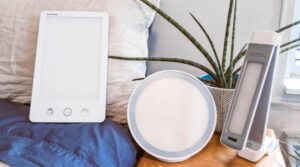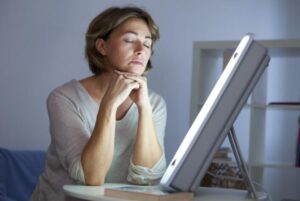Did you know that some depression is triggered due to change in season throughout the year? True.
SAD (Seasonal Affective Disorder) is a type of depression that changes the mood and saps the victim’s energy due to changes in serotonin and melatonin levels that disrupt the normal daily rhythms and is related to changes in seasons which begins and ends anytime at the onset of the new season depending with the person/victim.
The solution to SAD is UV rays, which boost the melatonin and serotonin level in the body to help relieve the condition.
People living far from the equator can use the SAD lamp, which is also the best alternative during fall and winter.
This article will introduce you to what SAD lamp is and how does it affect its users.
What Is a SAD Lamp?
A SAD Lamp is a lightbox that simulates sunlight that is used as a light therapy that helps to trigger the brain to releases more serotonin and reduces the secretion of melatonin hormone, thereby improving the victim’s mood and adjust the circadian cycle (regulating the sleep-wake cycle).
SAD lamp offers flicker free UV LED light technology with a light rating of 10,000 lux and a handy stand, and it is operated with two tilt angles for optimal usage.
The SAD lamp produces a very bright light that is about 29 times brighter than ordinary indoor light.
It is recommendable for SAD because it filters out the UV light, which is dangerous to your eyes and skin, making it safe for treatment especially people with certain eye diseases or people taking certain medications that increase sensitivity to sunlight may need to use alternative therapies or use light therapy under medical supervision.
However, it is worth noting that not all SAD lamp is for SAD, but other lightboxes are used for skin disorders which they primarily emit UV light and could damage your eyes if not correctly used.
How Do SAD Lamps Work?
The SAD lamp is one alternative for treating SAD, which is well known for boosting energy levels, putting you in a better mood, and making you feel more awake.
As mentioned above, a SAD lamp produces about 20 times (10,000 lux) brighter light than the ordinary outdoor light.
SAD lamp contains fluorescent lights mounted on a metal reflector and is fitted with a plastic screen to filter out damaging UV frequencies.
The screen also diffuses the emitted light to prevent glare. Thus, the SAD lamp’s critical thing is the intensity but not the morning’s spectrum, so full-spectrum light is not necessary.
Therefore, the light intensity works best when the user sits nearby at the prescribed distance and height, but the user must ensure that her eyes are open and looking slightly downwards because directly glaring at it is not suitable for the user’s eyes.
Therefore, sitting by this unique lamp for about 45-60 minutes daily in the morning and evening one hour before going to bed will stimulate the sunlight that’s missing during the darker winter months.
The SAD lamp light works to improve SAD by encouraging your brain to reduce melatonin hormone production, which is responsible for sleepiness and boosts the increase in serotonin hormone production accountable for mood stability.
The reason for using the SAD lamp is because the higher the amount of melatonin hormone, the high it affects the circadian rhythm, which is virtually under the control of the user’s gene. But, it can adjust to an environmental factor and mostly due to the changes in light and dark cycles.
Thus, the retina cells do respond differently with variation to the light intensity levels, which in turn signals the pacemaker to control the body rhythm, thereby regulating the production of melatonin hormone in the eyes.
Hence, the rise in melatonin levels in the evening is adequate to induce sleep and falls when exposed under the SAD lamp, which in turn increases the production of serotonin hormone in the brain to keep the user active and awake during the day.
Pros and Cons of Using a SAD Lamp
Pros
• It is easy to use since you only light up the lamp when your timing is about.
• It eliminates medication and injections, thereby cutting down the cost of using prescriptions and injections.
• The treatment is non-invasive and drug-free at most.
• It has limited to no side effects depending on the person’s reaction.
• The light therapy is safe compared to drugs that might have contra-indication with patients otherwise unknown illness and may cause complications.
• It is also convenient.
• Produces brighter light; this can be advantageous if you want faster results in your treatments.
• Most side effects can be dealt with by adjusting the duration and intensity of the sessions.
Cons
• In severe cases, a device is needed to produce higher luminosity levels of light to be effective.
• You need to consult your doctor after about a month of light therapy to check on the effectiveness.
Read More:
Here are some of the best light therapy lamps to relieve your depression.
- More lamps for SAD disorder, click here!
When to Use a SAD Lamp for Seasonal Affective Disorder?
Most people experience SAD at the beginning of fall and winter, so it is called “winter depression,” and they notice the rise of symptoms during the prolonged periods of cloudy or rainy weather.
Thus, most SAD patients begin treatment in the early fall and continue until spring when the outdoor light is sufficient to maintain their mood and energy levels.
However, SAD affects people differently concerning the change in seasons; hence, it is right for you and your doctor to adjust your light treatment based on your symptoms’ timing and duration.
How to Use a SAD Lamp for Seasonal Affective Disorder?
When using the SAD lamp in every session, you should sit near the lamp but not too close to it because it is not healthy for your eyes and skin.
– How to use?
However, it is believed that the light must enter your eyes for the treatment to be effective; therefore, you indirectly glare at it to avoid interfering with your eyes and ensure you follow the doctor’s recommendations and the manufacturer’s instructions on how to use it.
– Where to use?
Since SAD light treatment requires time and dedication, you should set the lamp near your reading desk, bed, or office table for you to get the most from it but ensure you do not overdo it by keeping up with the doctor’s prescription limit.
– What is the lighting distance?
When using the SAD lamp, the element for effectiveness is the proper combination of light intensity, duration, and timing.
That is, the typical recommendation is to use a 10,000 lux SAD lamp placed at a distance of about 60cm far from your face, and you should be exposed to the light at a duration (sessions) of about 45-60 minutes.
Still, it depends on the instructions daily, depending on your timing that works the best for you.
Helpful Tips for Light Therapy
However, if the SAD lamp is not sufficient, you should therefore try the following steps to get the most out of it, these are as follows;
• Be consistent- Always ensure you remain compatible with your daily light sessions to maintain your body responds to the light therapy and ensure you monitor your moods and other symptoms.
• Keep up with the timing- You should ensure you keep up with the right timing of your light therapy treatment because it determines when to start and end your light therapy treatment.
Thus, if you interrupt light therapy during winter or stop sooner in the spring because your symptoms are improving, the signs’ probability of return is higher.
So you should keep track of your timing correctly to avoid complications in the future.
• Use the right SAD lamp- before purchasing the SAD lamp, you should consult for professional advice from your doctor for you to get the right SAD light that is safe with proper brightness and suitable for your condition since there are different types of the SAD lamp depending on the degree of the SAD victim.
How Often to Use SAD Lamps?
What is essential with how often you use the SAD lamp is to orient the head and body toward the lights, concentrating on activities on the surfaces illuminated by the lights and not on the lights themselves.
Treatment sessions can last from 15 minutes to three hours, once or twice a day, depending on individual needs and equipment used.
While several required 1-hour exposures to show the effect. For example, lightboxes with lower lux rating usually require more time for response. For example, 5,000 lux light boxes require 45-60 minutes of daily exposure, while 2,500 lux light boxes require 1-2 hours of exposure.
Many people with winter depression respond best to treatment first thing upon awakening because it gives your body the natural signal that the day has begun.
As a result, your body clock/circadian rhythms can be regulated.
If you don’t have sufficient time in the mornings, then having a light therapy treatment in the afternoon is better than not using one at all.
Other Remedies for Seasonal Affective Disorder
• Medications
Medication is also one of the remedies for handling seasonal Affective Disorder through the prescription of antidepressants called selective serotonin reuptake inhibitors, which help correct the chemical imbalance that may lead to SAD.
Doctors do recommend you start with an antidepressant before your symptoms typically begin each year.
He or she may also recommend that you continue to take the antidepressant beyond the time your symptoms usually go away.
FDA also has approved another type of antidepressant, bupropion, in an extended-release form, that can prevent recurrence of seasonal major depressive episodes when taken daily from the fall until the following early spring.
Besides, it would be best if you kept in mind that it may take several weeks to notice full benefits from an antidepressant; thus, it may take you time to try different medications before finding one that works well for you and has the fewest side effects.
Therefore, it is vital to engage or talk to your doctor about the possible risk of using these medications for your condition.
• Psychotherapy or “Talk Therapy”
Psychotherapy is also called talk therapy, a cognitive-behavioral treatment that helps treat SAD by assisting the person in identifying the troubling emotions, thoughts, and behaviors that may/might cause SAD.
Psychotherapy is done by licensed and trained mental health care professionals and a patient meeting one-on-one or with other patients in a group setting.
It is typically conducted in two weekly group sessions for six weeks and focuses on replacing negative thoughts related to winter.
- The elements for the psychotherapist is to:
• Help and support a person to explore troubling issues and provide emotional support.
• Helping a person recognize the symptoms earlier and think about coping strategies, such as contacting friends, family, or emergency personnel.
• The therapist helps the person find ways to question these thoughts, understand how they affect emotions and behavior, try ways to change self-defeating patterns, and Identify ways to cope with stress.
• Provides a supportive environment that allows the SAD patient to tolerate the distress of individual items or ideas in which, over time, the fear associated with these things dissipates.
• Examines in-depth a person’s interactions with others and offering guidance with social and communication skills, if needed.
• Vitamin D
Administration of Vitamin D supplements or sunbathing directly under the sunlight will also offer a good alternative for treating SAD during the winter season because many SAD patients often lack vitamin D.
Therefore, taking vitamin D may also improve SAD symptoms.
FAQs
1. Do SAD Lamps Give You Vitamin D?
SAD lamps filter out most or all ultraviolet (UV) light, though due to its broad-spectrum light emitted from SAD lamps that help the skin to produce vitamin D.
However, it’s unclear whether vitamin D supplementation can help to relieve SAD symptoms. Very little research has been done on dietary supplements other than vitamin D for SAD.
2. Can You Get a Tan from a SAD Lamp?
Most light therapy systems shield out the ultraviolet light that causes tanning. Using the wrong type of lamp could damage your eyes and cause other side effects.
The kind of sun lamps used to treat SAD will not give you a tan. Occasionally, a person with susceptible skin shows reddening under full-spectrum lights, in which case complete UV-blocking, with filters, alternate bulbs, or a sunscreen lotion is needed.
However, this should not influence effectiveness since the adult eye does not pass UV light to the retina.
Conclusion
The SAD lamp is one of the best alternative used for improving SAD symptoms; therefore, it is best if you consult your doctor before you start using this mode of treatment because it has side effects, especially for the people who are suffering from Bi-polar, diabetes, skin issues and eye defects. However, it is worth noting that the SAD lamp does not treat SAD, but it also helps relieve its symptoms during the fall and winter season.



